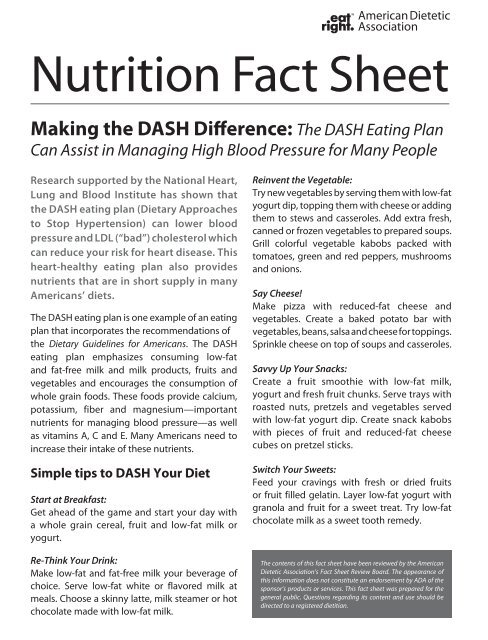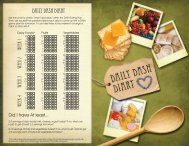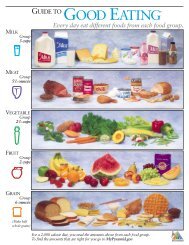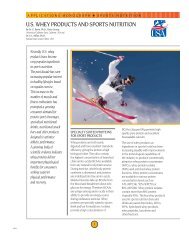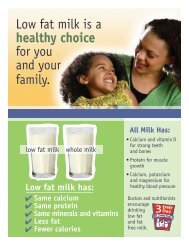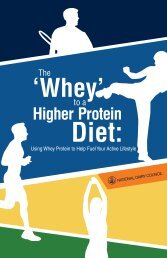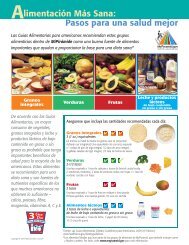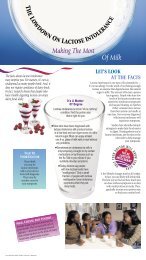Making the DASH Difference - National Dairy Council
Making the DASH Difference - National Dairy Council
Making the DASH Difference - National Dairy Council
You also want an ePaper? Increase the reach of your titles
YUMPU automatically turns print PDFs into web optimized ePapers that Google loves.
Nutrition Fact Sheet<br />
<strong>Making</strong> <strong>the</strong> <strong>DASH</strong> <strong>Difference</strong>: The <strong>DASH</strong> Eating Plan<br />
Can Assist in Managing High Blood Pressure for Many People<br />
Research supported by <strong>the</strong> <strong>National</strong> Heart,<br />
Lung and Blood Institute has shown that<br />
<strong>the</strong> <strong>DASH</strong> eating plan (Dietary Approaches<br />
to Stop Hypertension) can lower blood<br />
pressure and LDL (“bad”) cholesterol which<br />
can reduce your risk for heart disease. This<br />
heart-healthy eating plan also provides<br />
nutrients that are in short supply in many<br />
Americans’ diets.<br />
The <strong>DASH</strong> eating plan is one example of an eating<br />
plan that incorporates <strong>the</strong> recommendations of<br />
<strong>the</strong> Dietary Guidelines for Americans. The <strong>DASH</strong><br />
eating plan emphasizes consuming low-fat<br />
and fat-free milk and milk products, fruits and<br />
vegetables and encourages <strong>the</strong> consumption of<br />
whole grain foods. These foods provide calcium,<br />
potassium, fiber and magnesium—important<br />
nutrients for managing blood pressure—as well<br />
as vitamins A, C and E. Many Americans need to<br />
increase <strong>the</strong>ir intake of <strong>the</strong>se nutrients.<br />
Simple tips to <strong>DASH</strong> Your Diet<br />
Start at Breakfast:<br />
Get ahead of <strong>the</strong> game and start your day with<br />
a whole grain cereal, fruit and low-fat milk or<br />
yogurt.<br />
Re-Think Your Drink:<br />
Make low-fat and fat-free milk your beverage of<br />
choice. Serve low-fat white or flavored milk at<br />
meals. Choose a skinny latte, milk steamer or hot<br />
chocolate made with low-fat milk.<br />
Reinvent <strong>the</strong> Vegetable:<br />
Try new vegetables by serving <strong>the</strong>m with low-fat<br />
yogurt dip, topping <strong>the</strong>m with cheese or adding<br />
<strong>the</strong>m to stews and casseroles. Add extra fresh,<br />
canned or frozen vegetables to prepared soups.<br />
Grill colorful vegetable kabobs packed with<br />
tomatoes, green and red peppers, mushrooms<br />
and onions.<br />
Say Cheese!<br />
Make pizza with reduced-fat cheese and<br />
vegetables. Create a baked potato bar with<br />
vegetables, beans, salsa and cheese for toppings.<br />
Sprinkle cheese on top of soups and casseroles.<br />
Savvy Up Your Snacks:<br />
Create a fruit smoothie with low-fat milk,<br />
yogurt and fresh fruit chunks. Serve trays with<br />
roasted nuts, pretzels and vegetables served<br />
with low-fat yogurt dip. Create snack kabobs<br />
with pieces of fruit and reduced-fat cheese<br />
cubes on pretzel sticks.<br />
Switch Your Sweets:<br />
Feed your cravings with fresh or dried fruits<br />
or fruit filled gelatin. Layer low-fat yogurt with<br />
granola and fruit for a sweet treat. Try low-fat<br />
chocolate milk as a sweet tooth remedy.<br />
The contents of this fact sheet have been reviewed by <strong>the</strong> American<br />
Dietetic Association’s Fact Sheet Review Board. The appearance of<br />
this information does not constitute an endorsement by ADA of <strong>the</strong><br />
sponsor’s products or services. This fact sheet was prepared for <strong>the</strong><br />
general public. Questions regarding its content and use should be<br />
directed to a registered dietitian.
Make it with Milk:<br />
Use low-fat milk in place of water when cooking,<br />
especially with oatmeal, boxed rice and pasta<br />
dishes.<br />
Super Soups:<br />
Prepare soups with low-fat milk instead of water.<br />
Add extra fresh, canned or frozen vegetables to<br />
prepared soups.<br />
On <strong>the</strong> Go:<br />
Enjoy fresh fruit or single-serving packages of baby<br />
carrots, whole grain crackers, string cheese, yogurt<br />
smoothies or milk in chug-style containers when<br />
you are “dashing” around. You can easily eat<br />
<strong>the</strong>se in <strong>the</strong> car, at <strong>the</strong> office or on <strong>the</strong> road.<br />
Dining Out:<br />
Ask to substitute a side-salad, steamed<br />
vegetables or baked potato for French fries.<br />
Boost <strong>the</strong> nutrition in sandwiches by adding<br />
tomato, lettuce, peppers and o<strong>the</strong>r vegetables.<br />
For a sweet ending to your meal, choose a<br />
fresh seasonal fruit cup. Choose a nutrient-rich<br />
beverage with your meal, such as low-fat or<br />
fat-free milk or 100 percent fruit juice.<br />
Sample <strong>DASH</strong> Menu<br />
Breakfast<br />
¾ cup bran flakes cereal<br />
1 medium banana<br />
1 cup low-fat milk*<br />
1 slice whole wheat toast<br />
1 tsp soft (tub) margarine<br />
1 cup orange juice<br />
Lunch<br />
beef barbeque sandwich:<br />
2 oz beef, eye of round<br />
1 Tbsp barbeque sauce<br />
2 slices (1 ½ oz) natural cheddar cheese*,<br />
reduced fat<br />
1 hamburger bun<br />
1 large leaf romaine lettuce<br />
2 slices tomato<br />
1 cup new potato salad**<br />
1 small apple<br />
Dinner<br />
3 oz cod with1 tsp lemon juice<br />
½ cup brown rice<br />
1 cup spinach, cooked from frozen, sautéed<br />
with 1 tsp canola oil<br />
1 Tbsp almonds, slivered<br />
1 small cornbread muffin, made with oil<br />
1 tsp soft (tub) margarine<br />
Snacks<br />
1 cup fruit yogurt*, fat-free, no added sugar<br />
2 large graham cracker rectangles with<br />
1 Tbsp peanut butter<br />
*Note: For those with lactose sensitivity, try drinking<br />
lactose-reduced or lactose-free milk. Also, choose a<br />
yogurt with live and active cultures or hard cheeses<br />
such as Cheddar or Swiss, which are naturally low in<br />
lactose.<br />
** For recipes and additional calorie level menus, visit:<br />
www.nhlbi.nih.gov/health/public/heart/hbp/dash/<br />
new_dash.pdf<br />
For a referral to a registered dietitian and for additional food and nutrition information<br />
visit www.eatright.org<br />
This Nutrition Fact Sheet has been sponsored by<br />
The American Dietetic Association is <strong>the</strong> world’s largest organization<br />
of food and nutrition professionals. ADA is committed to improving<br />
<strong>the</strong> nation’s health and advancing <strong>the</strong> profession of dietetics<br />
through research, education and advocacy.<br />
For recipes, visit: www.3aday.org<br />
For health professional resources, visit:<br />
www.nationaldairycouncil.org<br />
©2008 ADA. Reproduction of this fact sheet is permitted for educational purposes. Reproduction for sales purposes is not authorized. This fact sheet expires 6/2011.


